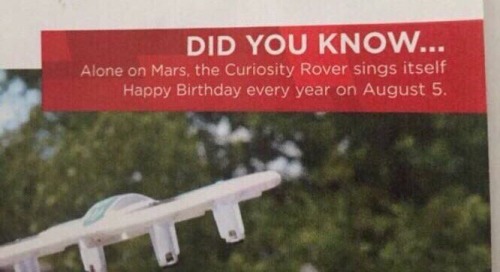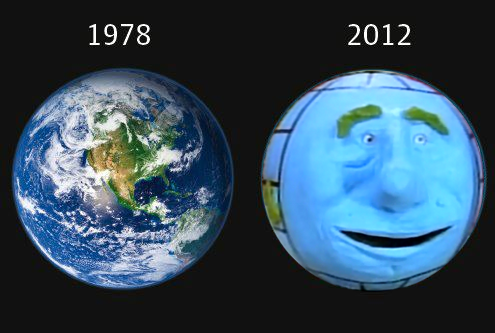An Asteroid Is Going To Fly Right By Earth In October, And Scientists Are Pumped

An asteroid is going to fly right by Earth in October, and scientists are pumped
Pretty soon, an asteroid is going to zip right past the Earth, but you shouldn’t be alarmed. Everything is going to be fine — and even better, NASA is going to use the opportunity to make sure we can protect ourselves from asteroids that could actually hit us.
Here’s the deal: An Italian astronomer spotted the asteroid, known as 2012 TC4, in 2012, when it flew past the Earth. At its closest approach, it was as close as a quarter of the distance between the Earth and the moon. Then its orbit took it too far from Earth for telescopes to watch it.
Now, it’s back, and on Oct. 12, it will again pass close to Earth. Astronomers haven’t pinned down its orbit precisely enough to say just how close it will get, since they only had a week of data from its 2012 visit. But they know it definitely won’t come closer than 4,200 miles away and expect it to stay much farther away than that. Read More (8/1/17)
More Posts from Plutoisnotaplanet and Others
Solar System: Things to Know This Week
The solar system is vast, and exploring it requires not one expedition, but many. From the sun to the Earth to the depths of space beyond Pluto, an entire fleet of spacecraft is pushing back the frontiers of knowledge. Scientists and engineers around the world work together on dozens of missions, and the results of their work unfold on a daily basis. During any given week, astronauts and robotic spacecraft return thousands of pictures and other data from Earth orbit and from half a dozen other worlds.
The result? It’s nothing short of a visual and intellectual feast. For example, all of the following images were obtained over the course of one week during January this year.
The same missions that took these pictures are still at work – they may be photographing Saturn or transmitting a report from Mars as you read this.
1. The Sun

From its clear vantage point in Earth orbit, our Solar Dynamics Observatory (SDO) observes our nearby star almost continuously. This image shows activity on the sun’s surface on Jan. 18. You can also get similar pictures from SDO daily!
2. The Earth from Afar

The DSCOVR satellite orbits the Earth at a distance of nearly a million miles (1.5 million kilometers). It’s Earth Polychromatic Imaging Camera (EPIC) keeps a steady watch on the home planet. This is how the world turned on Jan. 20. Get the latest daily images from EPIC HERE.
3. Mars from Above

The team that manages the Mars Reconnaissance Orbiter (MRO) recently celebrated a decade of observing the Red Planet. MRO took this detailed look at dunes and rocky buttes in Danielson Crater on Jan. 24. It was 3:06 p.m., local Mars time. On the right stide of the image, dust devils have left tracks in the sand.
4. Comet 67/P

The European Space Agency’s Rosetta probe caught this look at the surface of Comet 67/P from a distance of just 46 miles (75 kilometers) on Jan. 23.
5. Saturn

On the same day (Jan. 23), our Cassini spacecraft continued its odyssey of nearly two decades in space, bringing us this look at the sixth planet. See the latest images from Cassini HERE.
Want to learn more? Read our full list of the 10 things to know this week about the solar system HERE.
Make sure to follow us on Tumblr for your regular dose of space: http://nasa.tumblr.com
Black holes.....the ultimate succ
Another Message From Pluto
i’m a real twenty one pilots fan. i know more songs than just stressed out.
that doesn’t make me a planet though.
it should, but it doesn’t.

Pluto compared with Australia
How to Safely Watch the Aug. 21 Solar Eclipse
On Aug. 21, 2017, a solar eclipse will be visible in North America. Throughout the continent, the Moon will cover part – or all – of the Sun’s super-bright face for part of the day.

Since it’s never safe to look at the partially eclipsed or uneclipsed Sun, everyone who plans to watch the eclipse needs a plan to watch it safely. One of the easiest ways to watch an eclipse is solar viewing glasses – but there are a few things to check to make sure your glasses are safe:
Glasses should have an ISO 12312-2 certification
They should also have the manufacturer’s name and address, and you can check if the manufacturer has been verified by the American Astronomical Society
Make sure they have no scratches or damage

To use solar viewing glasses, make sure you put them on before looking up at the Sun, and look away before you remove them. Proper solar viewing glasses are extremely dark, and the landscape around you will be totally black when you put them on – all you should see is the Sun (and maybe some types of extremely bright lights if you have them nearby).
Never use solar viewing glasses while looking through a telescope, binoculars, camera viewfinder, or any other optical device. The concentrated solar rays will damage the filter and enter your eyes, causing serious injury. But you can use solar viewing glasses on top of your regular eyeglasses, if you use them!

If you don’t have solar viewing glasses, there are still ways to watch, like making your own pinhole projector. You can make a handheld box projector with just a few simple supplies – or simply hold any object with a small hole (like a piece of cardstock with a pinhole, or even a colander) above a piece of paper on the ground to project tiny images of the Sun.

Of course, you can also watch the entire eclipse online with us. Tune into nasa.gov/eclipselive starting at noon ET on Aug. 21!
For people in the path of totality, there will be a few brief moments when it is safe to look directly at the eclipse. Only once the Moon has completely covered the Sun and there is no light shining through is it safe to look at the eclipse. Make sure you put your eclipse glasses back on or return to indirect viewing before the first flash of sunlight appears around the Moon’s edge.

You can look up the length of the total eclipse in your area to help you set a time for the appropriate length of time. Remember – this only applies to people within the path of totality.
Everyone else will need to use eclipse glasses or indirect viewing throughout the entire eclipse!
Photographing the Eclipse
Whether you’re an amateur photographer or a selfie master, try out these tips for photographing the eclipse.

#1 — Safety first: Make sure you have the required solar filter to protect your camera.
#2 — Any camera is a good camera, whether it’s a high-end DSLR or a camera phone – a good eye and vision for the image you want to create is most important.
#3 — Look up, down, and all around. As the Moon slips in front of the Sun, the landscape will be bathed in long shadows, creating eerie lighting across the landscape. Light filtering through the overlapping leaves of trees, which creates natural pinholes, will also project mini eclipse replicas on the ground. Everywhere you can point your camera can yield exceptional imagery, so be sure to compose some wide-angle photos that can capture your eclipse experience.
#4 — Practice: Be sure you know the capabilities of your camera before Eclipse Day. Most cameras, and even many camera phones, have adjustable exposures, which can help you darken or lighten your image during the tricky eclipse lighting. Make sure you know how to manually focus the camera for crisp shots.
#5 —Upload your eclipse images to NASA’s Eclipse Flickr Gallery and relive the eclipse through other peoples’ images.
Learn all about the Aug. 21 eclipse at eclipse2017.nasa.gov, and follow @NASASun on Twitter and NASA Sun Science on Facebook for more. Watch the eclipse through the eyes of NASA at nasa.gov/eclipselive starting at 12 PM ET on Aug. 21.
Make sure to follow us on Tumblr for your regular dose of space: http://nasa.tumblr.com
um hello i did “sojourn at saturn” first
Solar System: Things to Know This Week
Our solar system is huge, so let us break it down for you. Here are a few things you should know this week:
1. Science at the Edge

As the New Horizons spacecraft speeds away at more than 31,000 miles per hour (14 km/s) it continues to explore the Kuiper Belt, the region of icy bodies beyond Neptune. New Horizons has now twice observed 1994 JR1, a 90-mile-wide object orbiting more than 3 billion miles from the sun.
2. A Spaceship, Refined

This artist’s rendering shows our Europa mission spacecraft, which is being developed for a launch sometime in the 2020s. The mission will place a spacecraft in orbit around Jupiter to explore the giant planet’s moon Europa. This updated concept image shows tow large solar arrays extending from the sides of the spacecraft, to which the mission’s ice-penetrating radar antennas are attached. A saucer-shaped high-gain antenna is also side mounted with a magnetometer boom placed next to it. Find out more about the spacecraft HERE.
3. Sojourn at Saturn

The Cassini spacecraft is hard at work this week, orbiting Saturn to study the planet and its rings. The recent pictures are spectacular, take a look at them HERE.
4. Talking Juno

Our Juno mission arrives at Jupiter on July 4, and that presents a unique opportunity for educators, science communicators and anyone interested in space exploration. We are providing a growing set of Juno-related information resources. Take a look at them HERE.
5. Now THAT’S a Long Distance Call

How do explorers on Earth talk to astronauts and robotic spacecraft flung across the far reaches of space? They use the remarkable technology deployed by our Space Communications and Navigation (SCaN) Program Office. This month, SCaN is celebrating its 10th anniversary of managing the ultimate network. Find out how it works HERE.
Want to learn more? Read our full list of the 10 things to know this week about the solar system HERE.
Make sure to follow us on Tumblr for your regular dose of space: http://nasa.tumblr.com


Everyone please make sure to wish the Mars Curiosity Rover a happy birthday today!
honey is the only food product that never spoils. there are pots of honey that are over five thousand years old and still completely edible
-
 neconriofu liked this · 1 year ago
neconriofu liked this · 1 year ago -
 anime-box97 liked this · 5 years ago
anime-box97 liked this · 5 years ago -
 ramvore liked this · 5 years ago
ramvore liked this · 5 years ago -
 idontknowwhatnametoputin liked this · 6 years ago
idontknowwhatnametoputin liked this · 6 years ago -
 atlantacpr liked this · 7 years ago
atlantacpr liked this · 7 years ago -
 starry-eyed-kookie-blog liked this · 7 years ago
starry-eyed-kookie-blog liked this · 7 years ago -
 flameskywolf liked this · 7 years ago
flameskywolf liked this · 7 years ago -
 lithnathron reblogged this · 7 years ago
lithnathron reblogged this · 7 years ago -
 lithnathron liked this · 7 years ago
lithnathron liked this · 7 years ago -
 vodkascums-blog liked this · 7 years ago
vodkascums-blog liked this · 7 years ago
welcome to my space space (see what i did there) (space means two different things)
232 posts
